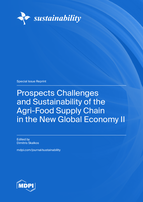Prospects Challenges and Sustainability of the Agri-Food Supply Chain in the New Global Economy II
A special issue of Sustainability (ISSN 2071-1050). This special issue belongs to the section "Sustainable Food".
Deadline for manuscript submissions: closed (28 June 2023) | Viewed by 26214
Special Issue Editor
Interests: food business management of innovation
Special Issues, Collections and Topics in MDPI journals
Special Issue Information
Dear Colleagues,
A year ago, when we announced the first edition of the current Special Issue, the world was rapidly changing due to the coronavirus effect. The world was transformed into a new form of capitalism with a growing anti-consumer movement that included five types of anti-consumers: life simplifiers, degrowth activists, climate activists, food choosers and conservation activists. It was expected that citizens would re-examine what they ate, how much they ate and how all of this would be influenced by class issues, inequality and eating habits with a more equitable form of food consumption (in the post-COVID-19 era). The food supply chain was expected to adjust to these new attitudes, dramatically changing in order to meet the new challenges of the upcoming global economy, as had been predicted.
However, a year later, the world is changing in an unpredictable and unprecedented way with unforeseen consequences. The agri-food supply chain is already at the center of these changes and worldwide studies due to the impending global economic crisis, with the added possibility of a food crisis.
Therefore, this second edition of the current Special Issue is now adapting to the present situation, recruiting papers not only concerning innovation, but also the prospects, challenges and sustainability of the agri-food supply chain, which can provide practical responses to the coming global tsunami. The scientific research concerning all aspects of the food chain are invited for submission, including technologies, new products, consumers’ perceptions, socioeconomic and environmental issues of conservation and sustainability, eco-innovation solutions and green transformative pathways in the agri-food sector.
Dr. Dimitris Skalkos
Guest Editor
Manuscript Submission Information
Manuscripts should be submitted online at www.mdpi.com by registering and logging in to this website. Once you are registered, click here to go to the submission form. Manuscripts can be submitted until the deadline. All submissions that pass pre-check are peer-reviewed. Accepted papers will be published continuously in the journal (as soon as accepted) and will be listed together on the special issue website. Research articles, review articles as well as short communications are invited. For planned papers, a title and short abstract (about 100 words) can be sent to the Editorial Office for announcement on this website.
Submitted manuscripts should not have been published previously, nor be under consideration for publication elsewhere (except conference proceedings papers). All manuscripts are thoroughly refereed through a single-blind peer-review process. A guide for authors and other relevant information for submission of manuscripts is available on the Instructions for Authors page. Sustainability is an international peer-reviewed open access semimonthly journal published by MDPI.
Please visit the Instructions for Authors page before submitting a manuscript. The Article Processing Charge (APC) for publication in this open access journal is 2400 CHF (Swiss Francs). Submitted papers should be well formatted and use good English. Authors may use MDPI's English editing service prior to publication or during author revisions.
Keywords
- food supply chain network
- innovation in food
- anti-consumerists
- new economy
- agri-food






